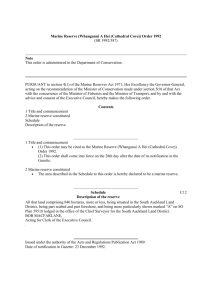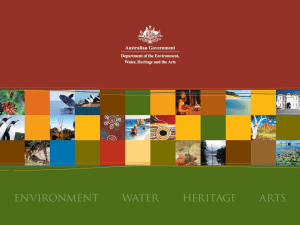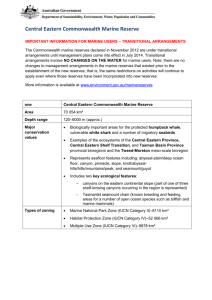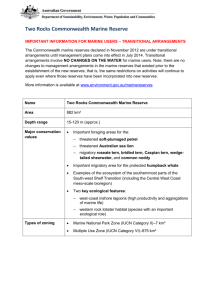Draft Management Plan for the Coral Sea Commonwealth Marine
advertisement
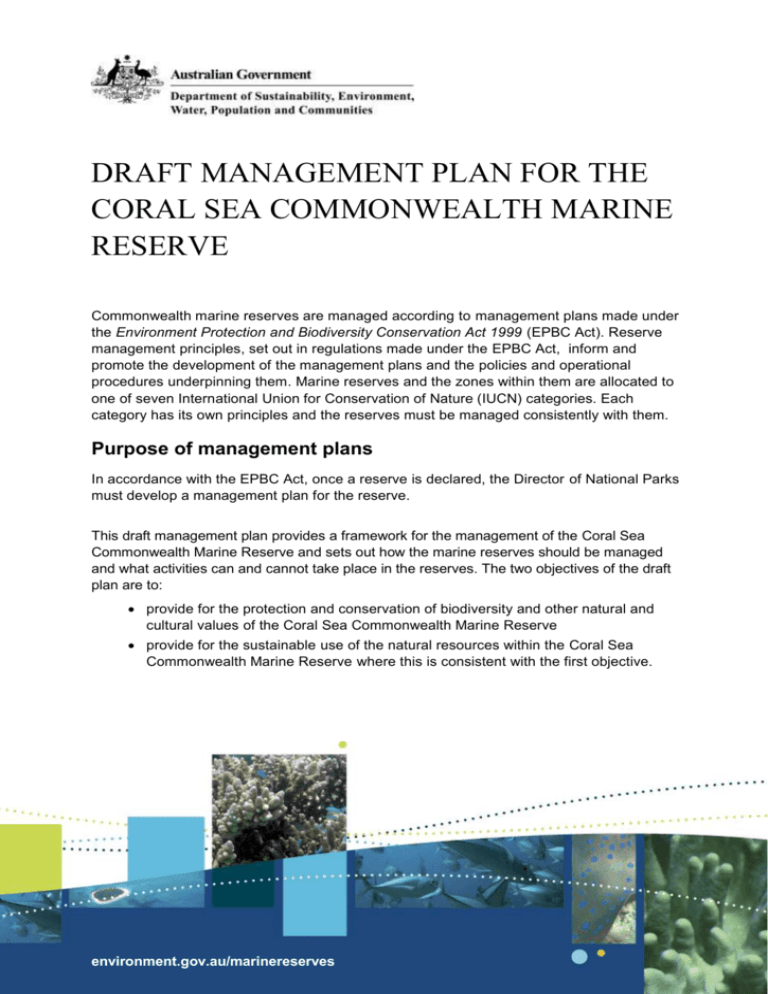
DRAFT MANAGEMENT PLAN FOR THE CORAL SEA COMMONWEALTH MARINE RESERVE Commonwealth marine reserves are managed according to management plans made under the Environment Protection and Biodiversity Conservation Act 1999 (EPBC Act). Reserve management principles, set out in regulations made under the EPBC Act, inform and promote the development of the management plans and the policies and operational procedures underpinning them. Marine reserves and the zones within them are allocated to one of seven International Union for Conservation of Nature (IUCN) categories. Each category has its own principles and the reserves must be managed consistently with them. Purpose of management plans In accordance with the EPBC Act, once a reserve is declared, the Director of National Parks must develop a management plan for the reserve. This draft management plan provides a framework for the management of the Coral Sea Commonwealth Marine Reserve and sets out how the marine reserves should be managed and what activities can and cannot take place in the reserves. The two objectives of the draft plan are to: provide for the protection and conservation of biodiversity and other natural and cultural values of the Coral Sea Commonwealth Marine Reserve provide for the sustainable use of the natural resources within the Coral Sea Commonwealth Marine Reserve where this is consistent with the first objective. environment.gov.au/marinereserves What is in a management plan? The draft management plan for the Coral Sea Commonwealth Marine Reserve: provides a broad description of the conservation values protected by the reserve and outlines the pressures and potential threats to these values, which require active management and monitoring over time to ensure the objectives of this management plan are achieved assigns an IUCN category to the reserve and to each zone within the reserve defines what activities can occur in each management zone and, in relation to these activities, sets out prescriptions designed to protect the marine environment and provide for ecologically sustainable use where this is allowed sets out the process for obtaining approval to conduct activities outlines the management strategies and actions for research and monitoring, assessment and permitting, compliance, community participation, Indigenous involvement and environmental management. These strategies and actions, together with the activity prescriptions, provide the framework for achieving the plan’s objectives and outcomes allows for management of local scale, reserve-specific issues during the life of the management plan, as management needs change over time. Zones and activities There are six management zones assigned to three IUCN categories in the Coral Sea Commonwealth Marine Reserve: Marine National Park Zone (IUCN category II) - intended to provide a high level of protection for the ecosystems, habitats and biodiversity within the zone. Activities involving the taking or harvesting of either living or non-living resources are prohibited. Conservation Park Zone (IUCN category IV) - intended to ensure maintenance of the habitat conditions necessary to protect the significant species, groups of species, biotic communities or physical features of the zone area. Provides a heightened level of protection to ensure the maintenance of habitats, particularly the habitats of reefs. Recreational fishing, other recreational uses, charter fishing and tourism are allowed. Some forms of commercial fishing are allowed and aquaculture, mining and oil and gas exploration and development are prohibited Habitat Protection Zone (Coral Sea) (IUCN category IV) - to be managed to ensure maintenance of the habitat conditions necessary to protect the significant species, groups of species, biotic communities or physical features of the environment. Provides a heightened level of protection to ensure the maintenance of habitats, including pelagic habitats. Most activities allowed as for Conservation Park Zone but allows some commercial fishing gear types not allowed in Conservation Park Zone. Habitat Protection Zone (Seamounts) (IUCN category IV) - to be managed to ensure maintenance of the habitat conditions necessary to protect the significant species, groups of species, biotic communities or physical features of the environment. Provides a heightened level of protection to ensure the maintenance of habitats, particularly seamount habitats. Most activities allowed as for Conservation Park Zone but allows some commercial fishing gear types not allowed in Conservation Park Zone. environment.gov.au/marinereserves 2 Multiple Use Zone (IUCN category VI) - intended to provide a heightened level of protection for ecosystems, habitats, and biodiversity, while allowing activities that are compatible with the primary objective of biodiversity conservation and the protection and maintenance of natural values in the long term. Most activities allowed as for Conservation Park Zone but allows some commercial fishing gear types not allowed in Conservation Park Zone and aquacultutre is not prohibited. General Use Zone (IUCN category VI) - intended to provide some protection for ecosystems, habitats, and biodiversity, while allowing activities broadly compatible with the primary objective of biodiversity conservation. Most activities allowed as for Conservation Park Zone but allows some commercial fishing gear types not allowed in Conservation Park Zone and aquacultutre is not prohibited. Within each zone, the management prescriptions outlined in Part 5 of the draft management plan specify whether or not actions and activities are allowed to occur; are allowable under a permit or class approval from the Director; or if they are prohibited. The draft management plan also sets out the rules for issuing and managing permits and class approvals. Strategies Seven management strategies and supporting actions are outlined in Part 4 of the draft management plan. These strategies and actions, together with the activity prescriptions, provide the framework to achieve the plan’s objectives. The strategies collectively support the protection of the conservation values of the marine reserves network while allowing for sustainable use. The strategies are: 1. Improve knowledge and understanding of the conservation values of the marine reserve and of the pressures on those values. 2. Minimise impacts of allowable activities through effective assessment of proposals, decision-making and management of activities. 3. Protect the conservation values of the marine reserve through management of environmental incidents. 4. Facilitate compliance with the management plan through education and enforcement. 5. Promote community understanding of, and stakeholder participation in, the management of the marine reserve. 6. Support involvement of Indigenous people in management of Commonwealth marine reserves. 7. Evaluate and report on the effectiveness of the management plan. Next steps The draft management plan for the Coral Sea Commonwealth Marine Reserve has been developed taking into account comments received during the first round of public consultation from 17 November 2012 to 18 December 2012. A second round of public consultation on the draft management plan is open from 14 January 2013 until 14 February 2013. The management plan will then be finalised, taking account of all public comments received, and considered and approved by the Minister. The environment.gov.au/marinereserves 3 intention is that the management plan for the Coral Sea Commonwealth Marine Reserve will be finalised in the first half of 2013, and will take effect on 1 July 2014. Until the new management plan comes into effect, transitional management arrangements will remain in place for the Coral Sea Commonwealth Marine Reserve. More information about transitional management arrangements is available at www.environment.gov.au/marinereserves. environment.gov.au/marinereserves 4

